Evaluating Human Fallibility and Just Culture in Risk Management Essay
VerifiedAdded on 2022/12/29
|8
|2371
|66
Essay
AI Summary
This essay delves into the critical aspects of risk management within organizations, focusing on the evaluation of human fallibility in the workplace and the application of a "just" culture to foster openness and accountability. The essay begins by defining risk management and its significance in achieving business objectives, highlighting the impact of human errors and the importance of developing an effective workplace culture. The main body of the essay examines human errors, including their detection and recovery approaches, and explores human attitudes toward risk and unsafe acts. It further analyzes various types of human errors, rule-based behaviors, and system failures, emphasizing the need for error detection and the importance of latent error identification. The essay then introduces the concept of a "just" culture, which emphasizes shared accountability, openness, and transparency. It explores how to build a workplace culture that encourages open communication, accountability, and employee participation in decision-making. The essay concludes by summarizing the key findings and reiterating the importance of risk management, human error mitigation, and the establishment of a just and open organizational culture for achieving business success.

Managing Risk
Paraphrase This Document
Need a fresh take? Get an instant paraphrase of this document with our AI Paraphraser
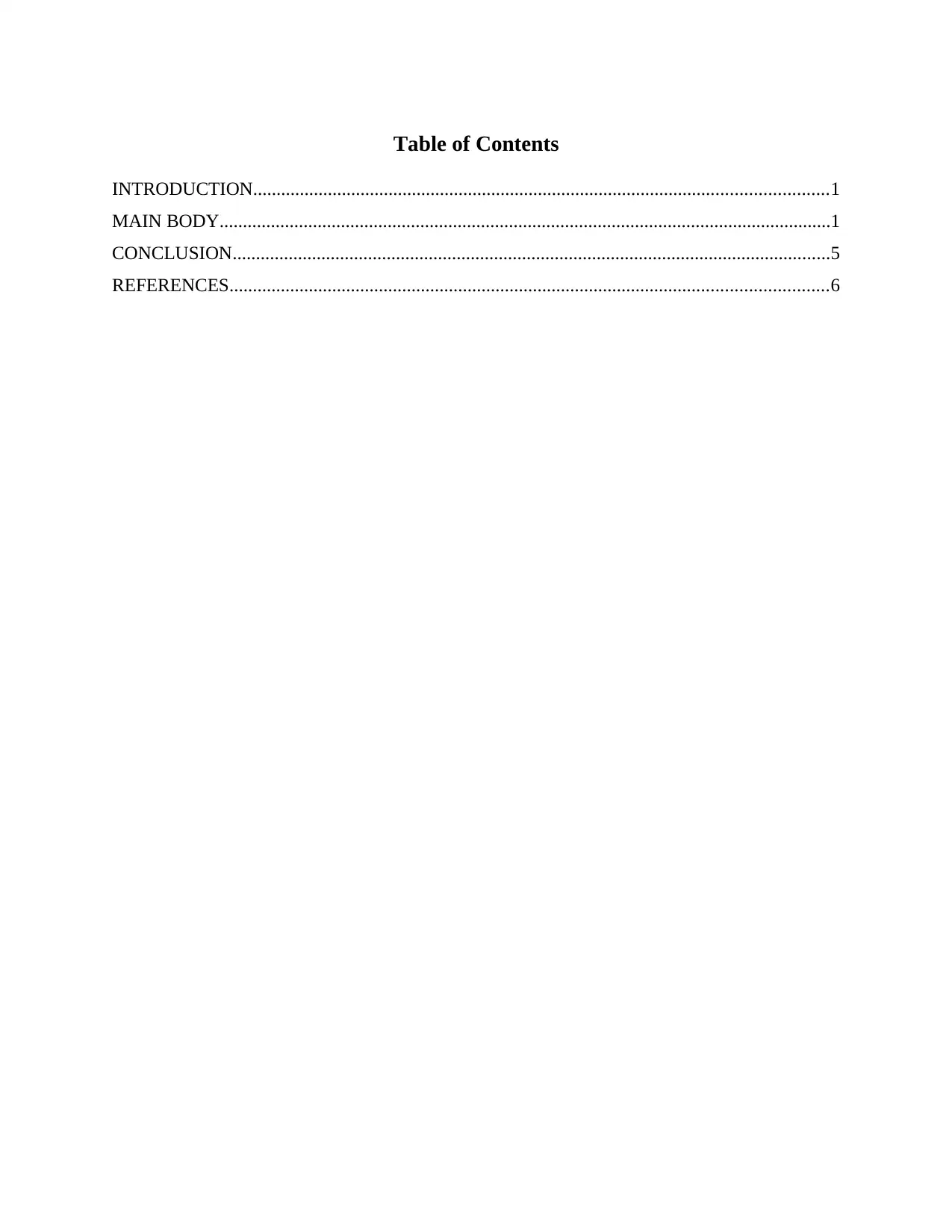
Table of Contents
INTRODUCTION...........................................................................................................................1
MAIN BODY...................................................................................................................................1
CONCLUSION................................................................................................................................5
REFERENCES................................................................................................................................6
INTRODUCTION...........................................................................................................................1
MAIN BODY...................................................................................................................................1
CONCLUSION................................................................................................................................5
REFERENCES................................................................................................................................6
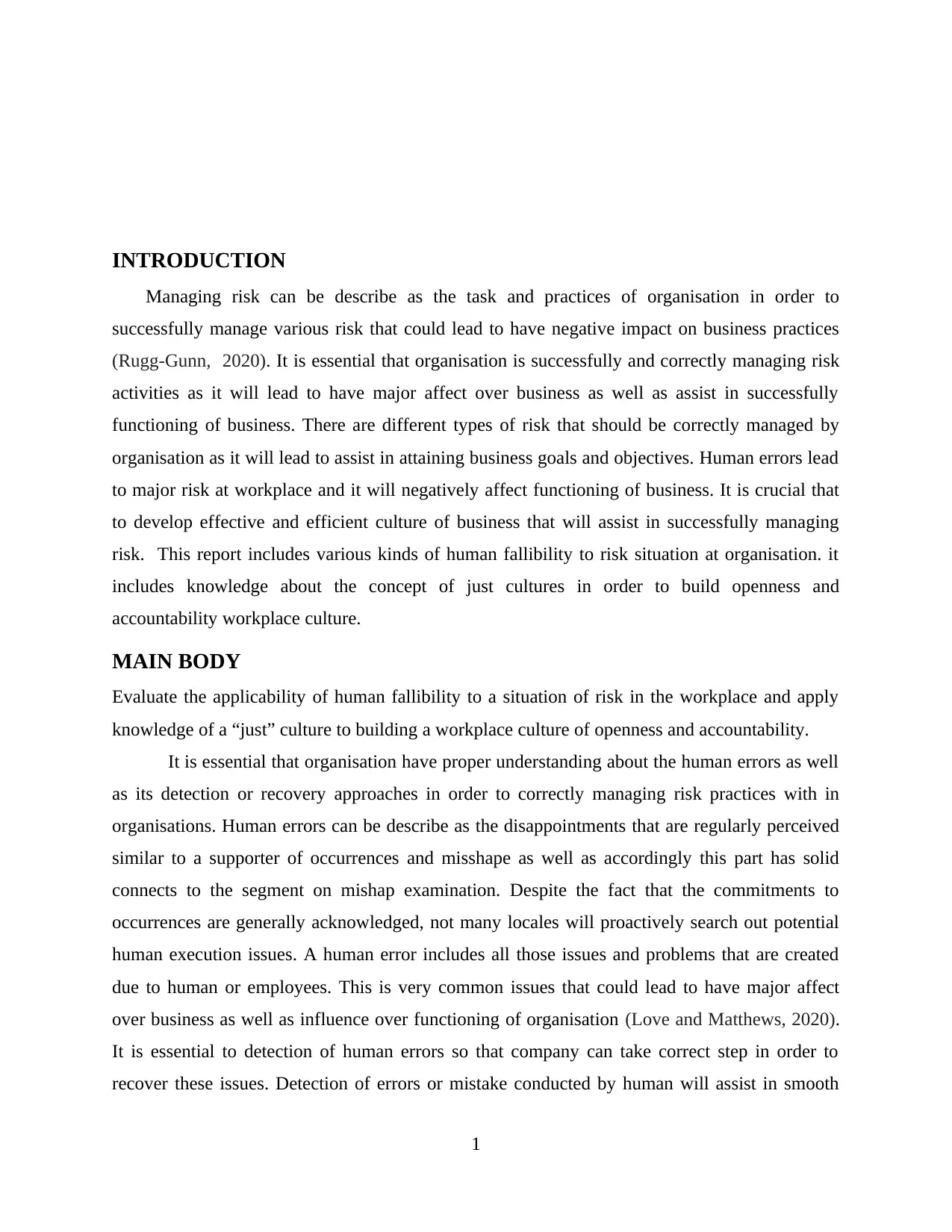
INTRODUCTION
Managing risk can be describe as the task and practices of organisation in order to
successfully manage various risk that could lead to have negative impact on business practices
(Rugg-Gunn, 2020). It is essential that organisation is successfully and correctly managing risk
activities as it will lead to have major affect over business as well as assist in successfully
functioning of business. There are different types of risk that should be correctly managed by
organisation as it will lead to assist in attaining business goals and objectives. Human errors lead
to major risk at workplace and it will negatively affect functioning of business. It is crucial that
to develop effective and efficient culture of business that will assist in successfully managing
risk. This report includes various kinds of human fallibility to risk situation at organisation. it
includes knowledge about the concept of just cultures in order to build openness and
accountability workplace culture.
MAIN BODY
Evaluate the applicability of human fallibility to a situation of risk in the workplace and apply
knowledge of a “just” culture to building a workplace culture of openness and accountability.
It is essential that organisation have proper understanding about the human errors as well
as its detection or recovery approaches in order to correctly managing risk practices with in
organisations. Human errors can be describe as the disappointments that are regularly perceived
similar to a supporter of occurrences and misshape as well as accordingly this part has solid
connects to the segment on mishap examination. Despite the fact that the commitments to
occurrences are generally acknowledged, not many locales will proactively search out potential
human execution issues. A human error includes all those issues and problems that are created
due to human or employees. This is very common issues that could lead to have major affect
over business as well as influence over functioning of organisation (Love and Matthews, 2020).
It is essential to detection of human errors so that company can take correct step in order to
recover these issues. Detection of errors or mistake conducted by human will assist in smooth
1
Managing risk can be describe as the task and practices of organisation in order to
successfully manage various risk that could lead to have negative impact on business practices
(Rugg-Gunn, 2020). It is essential that organisation is successfully and correctly managing risk
activities as it will lead to have major affect over business as well as assist in successfully
functioning of business. There are different types of risk that should be correctly managed by
organisation as it will lead to assist in attaining business goals and objectives. Human errors lead
to major risk at workplace and it will negatively affect functioning of business. It is crucial that
to develop effective and efficient culture of business that will assist in successfully managing
risk. This report includes various kinds of human fallibility to risk situation at organisation. it
includes knowledge about the concept of just cultures in order to build openness and
accountability workplace culture.
MAIN BODY
Evaluate the applicability of human fallibility to a situation of risk in the workplace and apply
knowledge of a “just” culture to building a workplace culture of openness and accountability.
It is essential that organisation have proper understanding about the human errors as well
as its detection or recovery approaches in order to correctly managing risk practices with in
organisations. Human errors can be describe as the disappointments that are regularly perceived
similar to a supporter of occurrences and misshape as well as accordingly this part has solid
connects to the segment on mishap examination. Despite the fact that the commitments to
occurrences are generally acknowledged, not many locales will proactively search out potential
human execution issues. A human error includes all those issues and problems that are created
due to human or employees. This is very common issues that could lead to have major affect
over business as well as influence over functioning of organisation (Love and Matthews, 2020).
It is essential to detection of human errors so that company can take correct step in order to
recover these issues. Detection of errors or mistake conducted by human will assist in smooth
1
⊘ This is a preview!⊘
Do you want full access?
Subscribe today to unlock all pages.

Trusted by 1+ million students worldwide
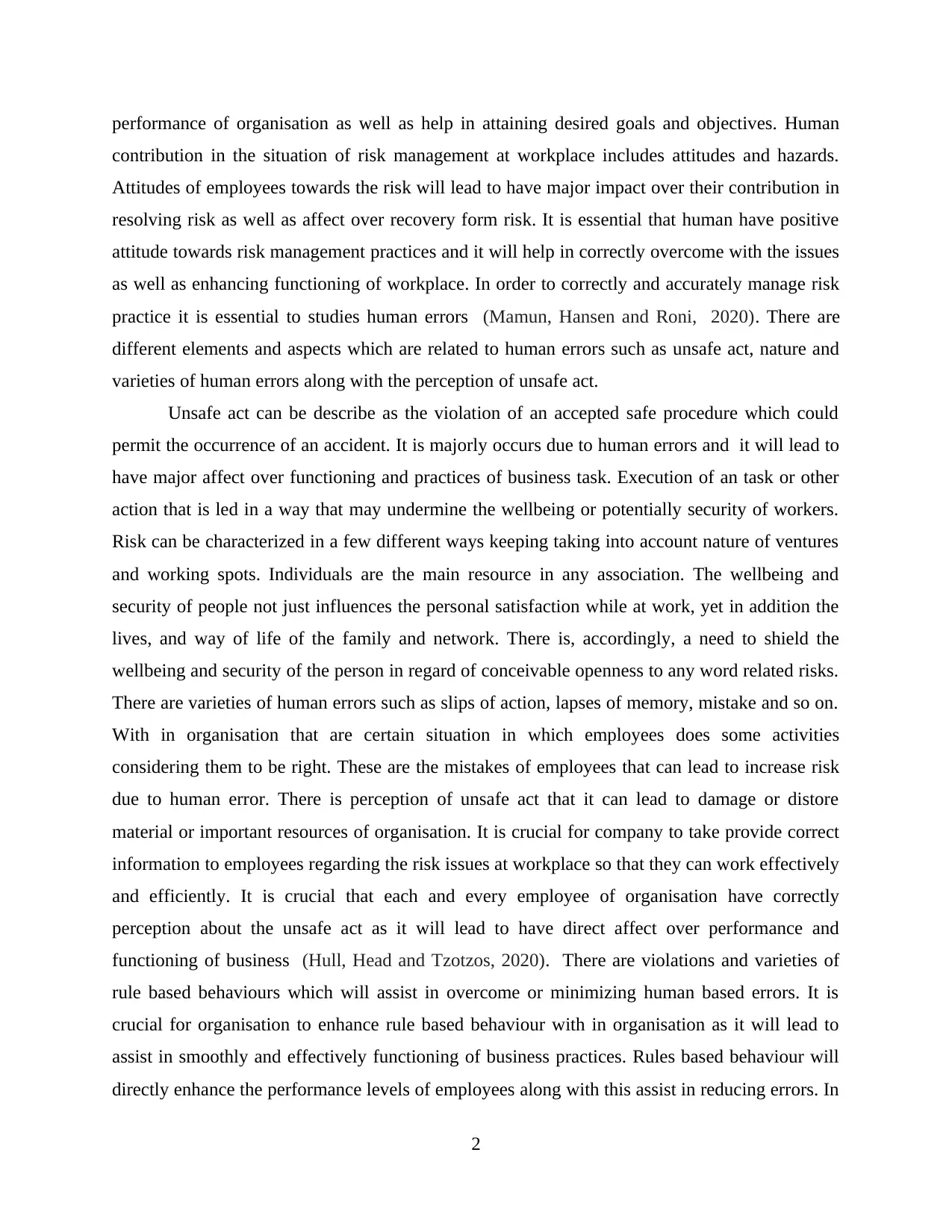
performance of organisation as well as help in attaining desired goals and objectives. Human
contribution in the situation of risk management at workplace includes attitudes and hazards.
Attitudes of employees towards the risk will lead to have major impact over their contribution in
resolving risk as well as affect over recovery form risk. It is essential that human have positive
attitude towards risk management practices and it will help in correctly overcome with the issues
as well as enhancing functioning of workplace. In order to correctly and accurately manage risk
practice it is essential to studies human errors (Mamun, Hansen and Roni, 2020). There are
different elements and aspects which are related to human errors such as unsafe act, nature and
varieties of human errors along with the perception of unsafe act.
Unsafe act can be describe as the violation of an accepted safe procedure which could
permit the occurrence of an accident. It is majorly occurs due to human errors and it will lead to
have major affect over functioning and practices of business task. Execution of an task or other
action that is led in a way that may undermine the wellbeing or potentially security of workers.
Risk can be characterized in a few different ways keeping taking into account nature of ventures
and working spots. Individuals are the main resource in any association. The wellbeing and
security of people not just influences the personal satisfaction while at work, yet in addition the
lives, and way of life of the family and network. There is, accordingly, a need to shield the
wellbeing and security of the person in regard of conceivable openness to any word related risks.
There are varieties of human errors such as slips of action, lapses of memory, mistake and so on.
With in organisation that are certain situation in which employees does some activities
considering them to be right. These are the mistakes of employees that can lead to increase risk
due to human error. There is perception of unsafe act that it can lead to damage or distore
material or important resources of organisation. It is crucial for company to take provide correct
information to employees regarding the risk issues at workplace so that they can work effectively
and efficiently. It is crucial that each and every employee of organisation have correctly
perception about the unsafe act as it will lead to have direct affect over performance and
functioning of business (Hull, Head and Tzotzos, 2020). There are violations and varieties of
rule based behaviours which will assist in overcome or minimizing human based errors. It is
crucial for organisation to enhance rule based behaviour with in organisation as it will lead to
assist in smoothly and effectively functioning of business practices. Rules based behaviour will
directly enhance the performance levels of employees along with this assist in reducing errors. In
2
contribution in the situation of risk management at workplace includes attitudes and hazards.
Attitudes of employees towards the risk will lead to have major impact over their contribution in
resolving risk as well as affect over recovery form risk. It is essential that human have positive
attitude towards risk management practices and it will help in correctly overcome with the issues
as well as enhancing functioning of workplace. In order to correctly and accurately manage risk
practice it is essential to studies human errors (Mamun, Hansen and Roni, 2020). There are
different elements and aspects which are related to human errors such as unsafe act, nature and
varieties of human errors along with the perception of unsafe act.
Unsafe act can be describe as the violation of an accepted safe procedure which could
permit the occurrence of an accident. It is majorly occurs due to human errors and it will lead to
have major affect over functioning and practices of business task. Execution of an task or other
action that is led in a way that may undermine the wellbeing or potentially security of workers.
Risk can be characterized in a few different ways keeping taking into account nature of ventures
and working spots. Individuals are the main resource in any association. The wellbeing and
security of people not just influences the personal satisfaction while at work, yet in addition the
lives, and way of life of the family and network. There is, accordingly, a need to shield the
wellbeing and security of the person in regard of conceivable openness to any word related risks.
There are varieties of human errors such as slips of action, lapses of memory, mistake and so on.
With in organisation that are certain situation in which employees does some activities
considering them to be right. These are the mistakes of employees that can lead to increase risk
due to human error. There is perception of unsafe act that it can lead to damage or distore
material or important resources of organisation. It is crucial for company to take provide correct
information to employees regarding the risk issues at workplace so that they can work effectively
and efficiently. It is crucial that each and every employee of organisation have correctly
perception about the unsafe act as it will lead to have direct affect over performance and
functioning of business (Hull, Head and Tzotzos, 2020). There are violations and varieties of
rule based behaviours which will assist in overcome or minimizing human based errors. It is
crucial for organisation to enhance rule based behaviour with in organisation as it will lead to
assist in smoothly and effectively functioning of business practices. Rules based behaviour will
directly enhance the performance levels of employees along with this assist in reducing errors. In
2
Paraphrase This Document
Need a fresh take? Get an instant paraphrase of this document with our AI Paraphraser
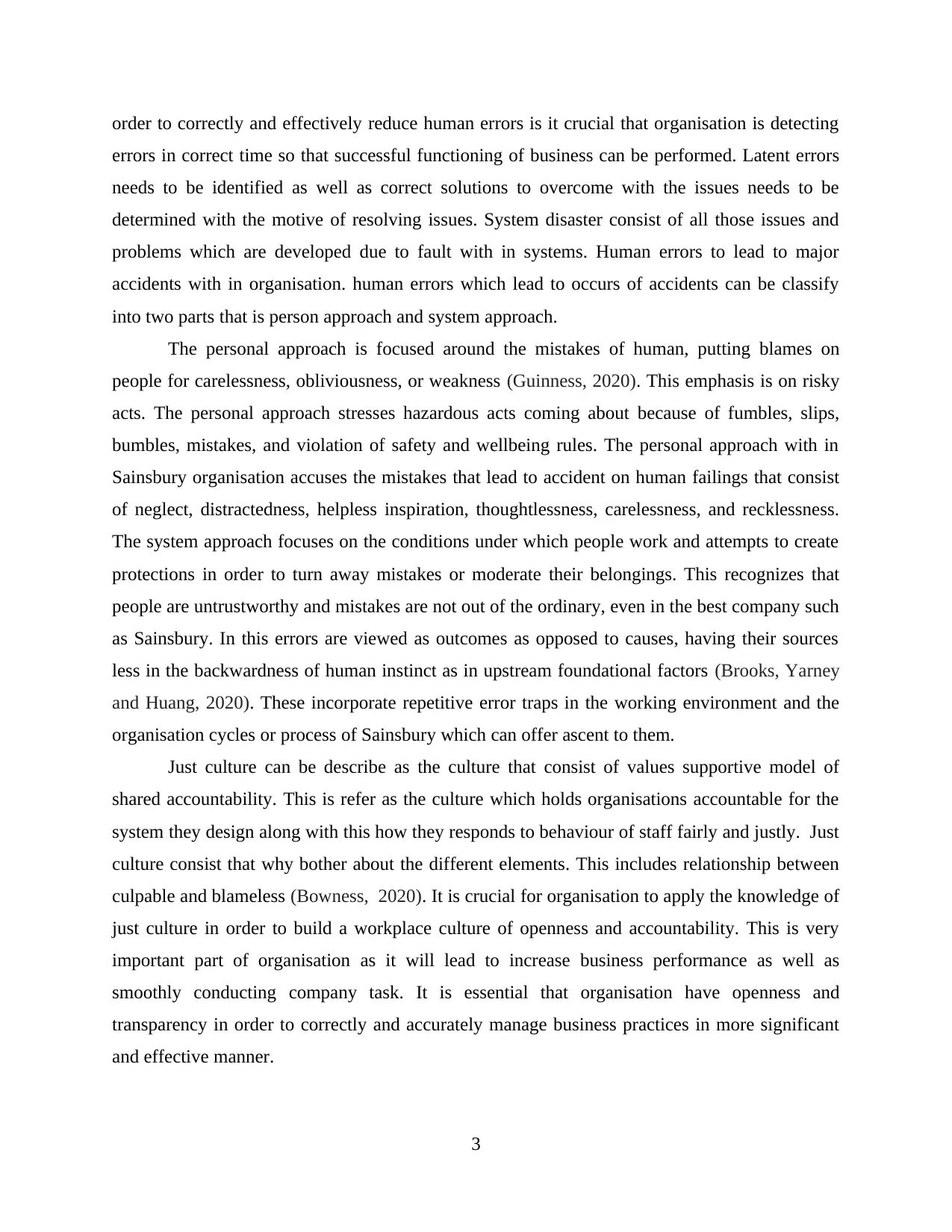
order to correctly and effectively reduce human errors is it crucial that organisation is detecting
errors in correct time so that successful functioning of business can be performed. Latent errors
needs to be identified as well as correct solutions to overcome with the issues needs to be
determined with the motive of resolving issues. System disaster consist of all those issues and
problems which are developed due to fault with in systems. Human errors to lead to major
accidents with in organisation. human errors which lead to occurs of accidents can be classify
into two parts that is person approach and system approach.
The personal approach is focused around the mistakes of human, putting blames on
people for carelessness, obliviousness, or weakness (Guinness, 2020). This emphasis is on risky
acts. The personal approach stresses hazardous acts coming about because of fumbles, slips,
bumbles, mistakes, and violation of safety and wellbeing rules. The personal approach with in
Sainsbury organisation accuses the mistakes that lead to accident on human failings that consist
of neglect, distractedness, helpless inspiration, thoughtlessness, carelessness, and recklessness.
The system approach focuses on the conditions under which people work and attempts to create
protections in order to turn away mistakes or moderate their belongings. This recognizes that
people are untrustworthy and mistakes are not out of the ordinary, even in the best company such
as Sainsbury. In this errors are viewed as outcomes as opposed to causes, having their sources
less in the backwardness of human instinct as in upstream foundational factors (Brooks, Yarney
and Huang, 2020). These incorporate repetitive error traps in the working environment and the
organisation cycles or process of Sainsbury which can offer ascent to them.
Just culture can be describe as the culture that consist of values supportive model of
shared accountability. This is refer as the culture which holds organisations accountable for the
system they design along with this how they responds to behaviour of staff fairly and justly. Just
culture consist that why bother about the different elements. This includes relationship between
culpable and blameless (Bowness, 2020). It is crucial for organisation to apply the knowledge of
just culture in order to build a workplace culture of openness and accountability. This is very
important part of organisation as it will lead to increase business performance as well as
smoothly conducting company task. It is essential that organisation have openness and
transparency in order to correctly and accurately manage business practices in more significant
and effective manner.
3
errors in correct time so that successful functioning of business can be performed. Latent errors
needs to be identified as well as correct solutions to overcome with the issues needs to be
determined with the motive of resolving issues. System disaster consist of all those issues and
problems which are developed due to fault with in systems. Human errors to lead to major
accidents with in organisation. human errors which lead to occurs of accidents can be classify
into two parts that is person approach and system approach.
The personal approach is focused around the mistakes of human, putting blames on
people for carelessness, obliviousness, or weakness (Guinness, 2020). This emphasis is on risky
acts. The personal approach stresses hazardous acts coming about because of fumbles, slips,
bumbles, mistakes, and violation of safety and wellbeing rules. The personal approach with in
Sainsbury organisation accuses the mistakes that lead to accident on human failings that consist
of neglect, distractedness, helpless inspiration, thoughtlessness, carelessness, and recklessness.
The system approach focuses on the conditions under which people work and attempts to create
protections in order to turn away mistakes or moderate their belongings. This recognizes that
people are untrustworthy and mistakes are not out of the ordinary, even in the best company such
as Sainsbury. In this errors are viewed as outcomes as opposed to causes, having their sources
less in the backwardness of human instinct as in upstream foundational factors (Brooks, Yarney
and Huang, 2020). These incorporate repetitive error traps in the working environment and the
organisation cycles or process of Sainsbury which can offer ascent to them.
Just culture can be describe as the culture that consist of values supportive model of
shared accountability. This is refer as the culture which holds organisations accountable for the
system they design along with this how they responds to behaviour of staff fairly and justly. Just
culture consist that why bother about the different elements. This includes relationship between
culpable and blameless (Bowness, 2020). It is crucial for organisation to apply the knowledge of
just culture in order to build a workplace culture of openness and accountability. This is very
important part of organisation as it will lead to increase business performance as well as
smoothly conducting company task. It is essential that organisation have openness and
transparency in order to correctly and accurately manage business practices in more significant
and effective manner.
3
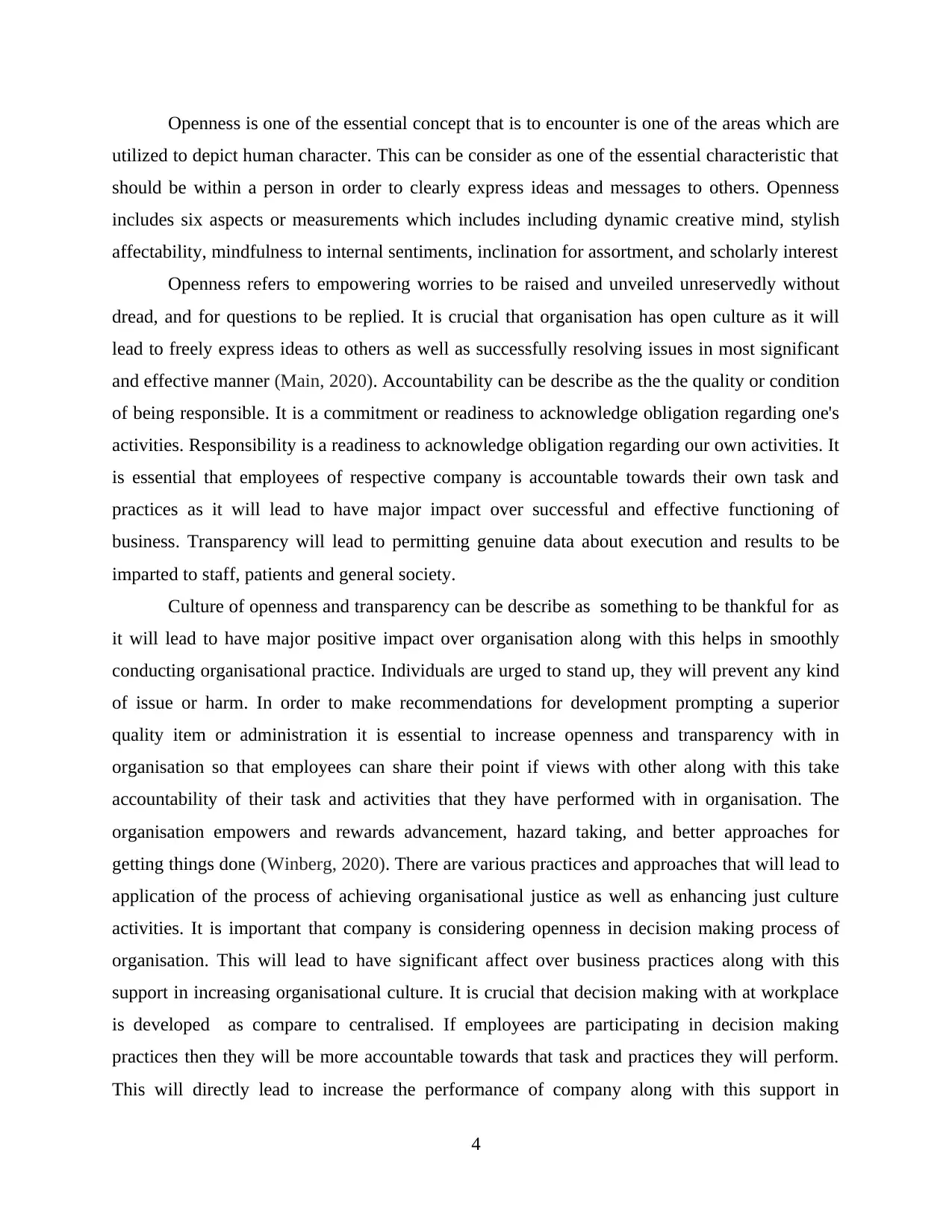
Openness is one of the essential concept that is to encounter is one of the areas which are
utilized to depict human character. This can be consider as one of the essential characteristic that
should be within a person in order to clearly express ideas and messages to others. Openness
includes six aspects or measurements which includes including dynamic creative mind, stylish
affectability, mindfulness to internal sentiments, inclination for assortment, and scholarly interest
Openness refers to empowering worries to be raised and unveiled unreservedly without
dread, and for questions to be replied. It is crucial that organisation has open culture as it will
lead to freely express ideas to others as well as successfully resolving issues in most significant
and effective manner (Main, 2020). Accountability can be describe as the the quality or condition
of being responsible. It is a commitment or readiness to acknowledge obligation regarding one's
activities. Responsibility is a readiness to acknowledge obligation regarding our own activities. It
is essential that employees of respective company is accountable towards their own task and
practices as it will lead to have major impact over successful and effective functioning of
business. Transparency will lead to permitting genuine data about execution and results to be
imparted to staff, patients and general society.
Culture of openness and transparency can be describe as something to be thankful for as
it will lead to have major positive impact over organisation along with this helps in smoothly
conducting organisational practice. Individuals are urged to stand up, they will prevent any kind
of issue or harm. In order to make recommendations for development prompting a superior
quality item or administration it is essential to increase openness and transparency with in
organisation so that employees can share their point if views with other along with this take
accountability of their task and activities that they have performed with in organisation. The
organisation empowers and rewards advancement, hazard taking, and better approaches for
getting things done (Winberg, 2020). There are various practices and approaches that will lead to
application of the process of achieving organisational justice as well as enhancing just culture
activities. It is important that company is considering openness in decision making process of
organisation. This will lead to have significant affect over business practices along with this
support in increasing organisational culture. It is crucial that decision making with at workplace
is developed as compare to centralised. If employees are participating in decision making
practices then they will be more accountable towards that task and practices they will perform.
This will directly lead to increase the performance of company along with this support in
4
utilized to depict human character. This can be consider as one of the essential characteristic that
should be within a person in order to clearly express ideas and messages to others. Openness
includes six aspects or measurements which includes including dynamic creative mind, stylish
affectability, mindfulness to internal sentiments, inclination for assortment, and scholarly interest
Openness refers to empowering worries to be raised and unveiled unreservedly without
dread, and for questions to be replied. It is crucial that organisation has open culture as it will
lead to freely express ideas to others as well as successfully resolving issues in most significant
and effective manner (Main, 2020). Accountability can be describe as the the quality or condition
of being responsible. It is a commitment or readiness to acknowledge obligation regarding one's
activities. Responsibility is a readiness to acknowledge obligation regarding our own activities. It
is essential that employees of respective company is accountable towards their own task and
practices as it will lead to have major impact over successful and effective functioning of
business. Transparency will lead to permitting genuine data about execution and results to be
imparted to staff, patients and general society.
Culture of openness and transparency can be describe as something to be thankful for as
it will lead to have major positive impact over organisation along with this helps in smoothly
conducting organisational practice. Individuals are urged to stand up, they will prevent any kind
of issue or harm. In order to make recommendations for development prompting a superior
quality item or administration it is essential to increase openness and transparency with in
organisation so that employees can share their point if views with other along with this take
accountability of their task and activities that they have performed with in organisation. The
organisation empowers and rewards advancement, hazard taking, and better approaches for
getting things done (Winberg, 2020). There are various practices and approaches that will lead to
application of the process of achieving organisational justice as well as enhancing just culture
activities. It is important that company is considering openness in decision making process of
organisation. This will lead to have significant affect over business practices along with this
support in increasing organisational culture. It is crucial that decision making with at workplace
is developed as compare to centralised. If employees are participating in decision making
practices then they will be more accountable towards that task and practices they will perform.
This will directly lead to increase the performance of company along with this support in
4
⊘ This is a preview!⊘
Do you want full access?
Subscribe today to unlock all pages.

Trusted by 1+ million students worldwide
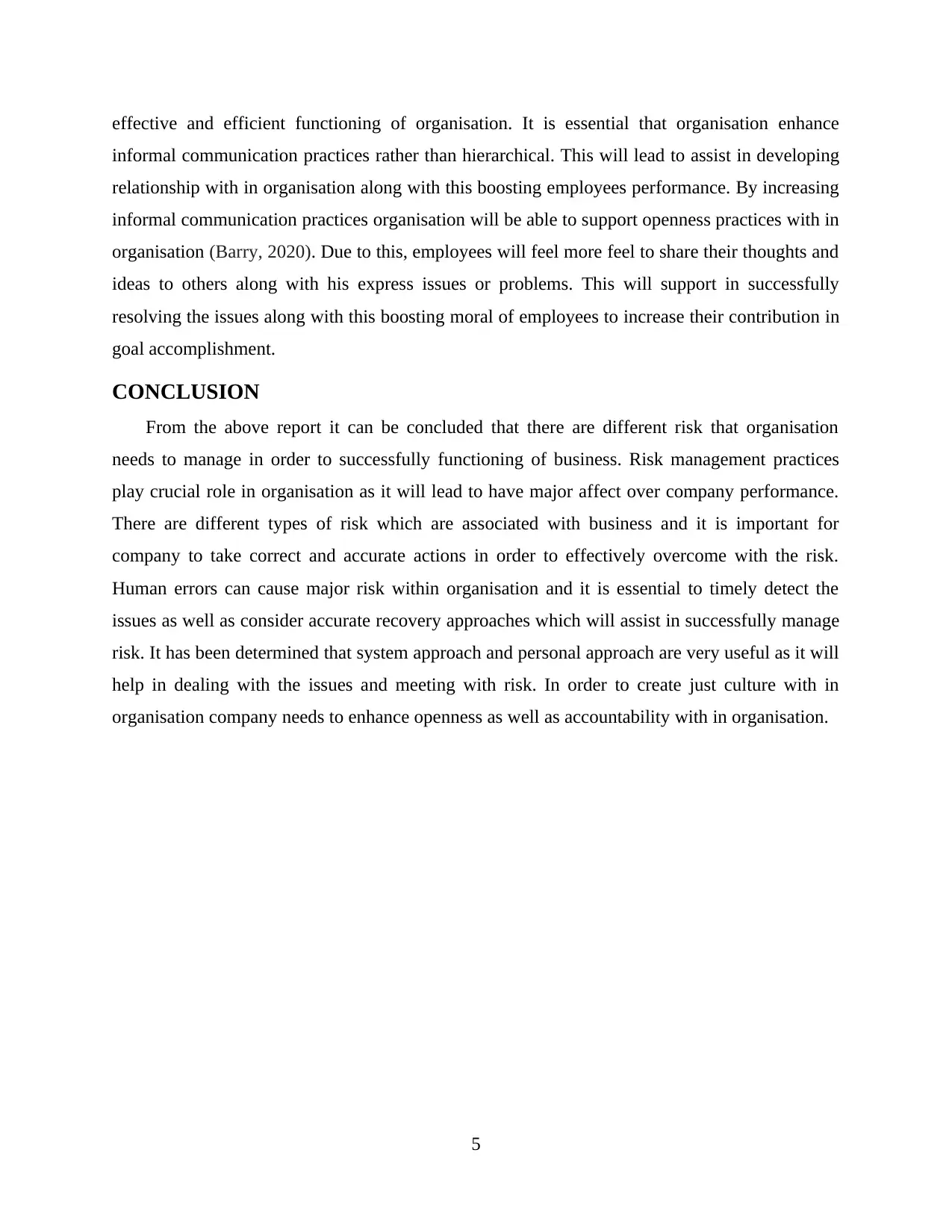
effective and efficient functioning of organisation. It is essential that organisation enhance
informal communication practices rather than hierarchical. This will lead to assist in developing
relationship with in organisation along with this boosting employees performance. By increasing
informal communication practices organisation will be able to support openness practices with in
organisation (Barry, 2020). Due to this, employees will feel more feel to share their thoughts and
ideas to others along with his express issues or problems. This will support in successfully
resolving the issues along with this boosting moral of employees to increase their contribution in
goal accomplishment.
CONCLUSION
From the above report it can be concluded that there are different risk that organisation
needs to manage in order to successfully functioning of business. Risk management practices
play crucial role in organisation as it will lead to have major affect over company performance.
There are different types of risk which are associated with business and it is important for
company to take correct and accurate actions in order to effectively overcome with the risk.
Human errors can cause major risk within organisation and it is essential to timely detect the
issues as well as consider accurate recovery approaches which will assist in successfully manage
risk. It has been determined that system approach and personal approach are very useful as it will
help in dealing with the issues and meeting with risk. In order to create just culture with in
organisation company needs to enhance openness as well as accountability with in organisation.
5
informal communication practices rather than hierarchical. This will lead to assist in developing
relationship with in organisation along with this boosting employees performance. By increasing
informal communication practices organisation will be able to support openness practices with in
organisation (Barry, 2020). Due to this, employees will feel more feel to share their thoughts and
ideas to others along with his express issues or problems. This will support in successfully
resolving the issues along with this boosting moral of employees to increase their contribution in
goal accomplishment.
CONCLUSION
From the above report it can be concluded that there are different risk that organisation
needs to manage in order to successfully functioning of business. Risk management practices
play crucial role in organisation as it will lead to have major affect over company performance.
There are different types of risk which are associated with business and it is important for
company to take correct and accurate actions in order to effectively overcome with the risk.
Human errors can cause major risk within organisation and it is essential to timely detect the
issues as well as consider accurate recovery approaches which will assist in successfully manage
risk. It has been determined that system approach and personal approach are very useful as it will
help in dealing with the issues and meeting with risk. In order to create just culture with in
organisation company needs to enhance openness as well as accountability with in organisation.
5
Paraphrase This Document
Need a fresh take? Get an instant paraphrase of this document with our AI Paraphraser
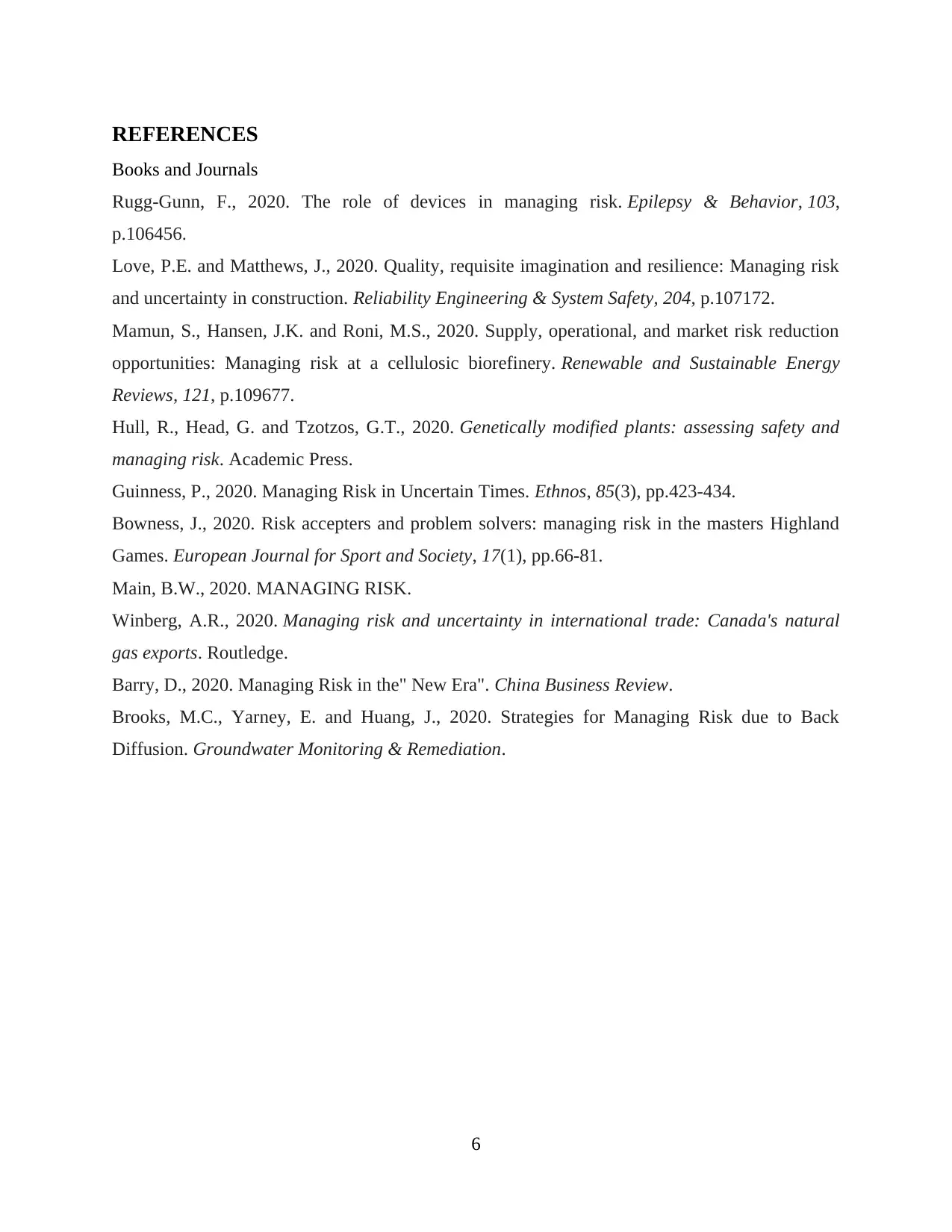
REFERENCES
Books and Journals
Rugg-Gunn, F., 2020. The role of devices in managing risk. Epilepsy & Behavior, 103,
p.106456.
Love, P.E. and Matthews, J., 2020. Quality, requisite imagination and resilience: Managing risk
and uncertainty in construction. Reliability Engineering & System Safety, 204, p.107172.
Mamun, S., Hansen, J.K. and Roni, M.S., 2020. Supply, operational, and market risk reduction
opportunities: Managing risk at a cellulosic biorefinery. Renewable and Sustainable Energy
Reviews, 121, p.109677.
Hull, R., Head, G. and Tzotzos, G.T., 2020. Genetically modified plants: assessing safety and
managing risk. Academic Press.
Guinness, P., 2020. Managing Risk in Uncertain Times. Ethnos, 85(3), pp.423-434.
Bowness, J., 2020. Risk accepters and problem solvers: managing risk in the masters Highland
Games. European Journal for Sport and Society, 17(1), pp.66-81.
Main, B.W., 2020. MANAGING RISK.
Winberg, A.R., 2020. Managing risk and uncertainty in international trade: Canada's natural
gas exports. Routledge.
Barry, D., 2020. Managing Risk in the" New Era". China Business Review.
Brooks, M.C., Yarney, E. and Huang, J., 2020. Strategies for Managing Risk due to Back
Diffusion. Groundwater Monitoring & Remediation.
6
Books and Journals
Rugg-Gunn, F., 2020. The role of devices in managing risk. Epilepsy & Behavior, 103,
p.106456.
Love, P.E. and Matthews, J., 2020. Quality, requisite imagination and resilience: Managing risk
and uncertainty in construction. Reliability Engineering & System Safety, 204, p.107172.
Mamun, S., Hansen, J.K. and Roni, M.S., 2020. Supply, operational, and market risk reduction
opportunities: Managing risk at a cellulosic biorefinery. Renewable and Sustainable Energy
Reviews, 121, p.109677.
Hull, R., Head, G. and Tzotzos, G.T., 2020. Genetically modified plants: assessing safety and
managing risk. Academic Press.
Guinness, P., 2020. Managing Risk in Uncertain Times. Ethnos, 85(3), pp.423-434.
Bowness, J., 2020. Risk accepters and problem solvers: managing risk in the masters Highland
Games. European Journal for Sport and Society, 17(1), pp.66-81.
Main, B.W., 2020. MANAGING RISK.
Winberg, A.R., 2020. Managing risk and uncertainty in international trade: Canada's natural
gas exports. Routledge.
Barry, D., 2020. Managing Risk in the" New Era". China Business Review.
Brooks, M.C., Yarney, E. and Huang, J., 2020. Strategies for Managing Risk due to Back
Diffusion. Groundwater Monitoring & Remediation.
6
1 out of 8
Related Documents
Your All-in-One AI-Powered Toolkit for Academic Success.
+13062052269
info@desklib.com
Available 24*7 on WhatsApp / Email
![[object Object]](/_next/static/media/star-bottom.7253800d.svg)
Unlock your academic potential
Copyright © 2020–2025 A2Z Services. All Rights Reserved. Developed and managed by ZUCOL.





